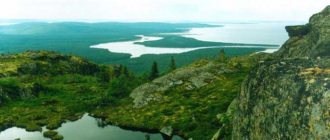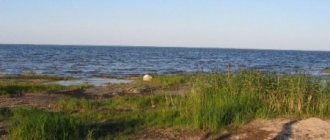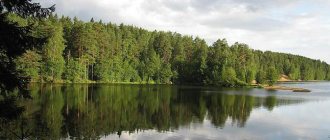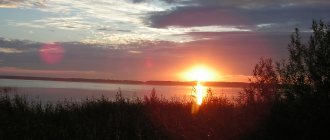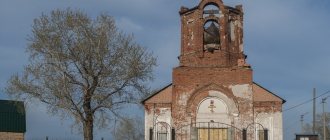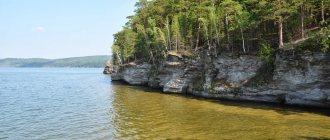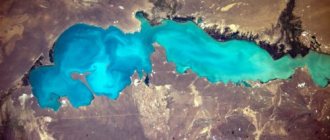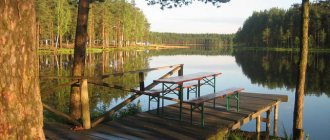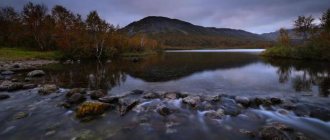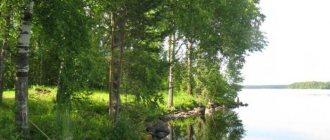Hydrology
- Availability of permanent drainage: yes, wastewater.
- Tributaries: Kungurusha, Kundrusha, Elovka.
- Source: Koelga River.
- Bottom: rocky and pebbly, muddy in places.
Chemical composition
- Water: fresh.
- Salinity: 0.46 g/l.
- Water class according to salt composition: hydrocarbonate with mixed cationic composition.
- Transparency: 6.5 m.
Geography
- Coordinates: 54°57′39″ N. latitude, 60°19′02″ e. d.
- Altitude above sea level: 320.6 m.
- Coastal landscape: the western shore of the lake is hilly, covered with a mixed pine-birch forest - there are several recreation centers, the eastern shore is open, with small groves of deciduous trees (mostly birch) - the city is located here. In the southern part of the lake, wetlands are common along the shores.
- Settlements on the banks: Kisegach, Chebarkul
Territorial location
- COUNTRY: RF . Region: Chelyabinsk region . District: Chebarkulsky.
Interactive map
Weather on Lake Chebarkul
The warmest month in the Chelyabinsk region is July. Usually in mid-summer the heat lasts for several days at 30 degrees, so the water in the lake can warm up to a comfortable +20°C. In general, the average air temperature in summer is between +16.4°C…+19.2°C.
The coldest month is usually January - frosts of 30 degrees are possible in the middle of winter. However, the average air temperature during the three winter months ranges from -11.7°C to -14.9°C.
© Ruslan Garipov
Attractions
Chebarkulsky pine forest
The western shore of the lake is bordered by Chebarkulsky Bor, a specially protected area with the status of a botanical natural monument. This is an island forest located in the foothill zone, near the eastern slopes of the Ilmensky ridge. It is notable for its flora, primarily for plants listed in the Red Book.
Hunnic mounds
Ancient burials located on the southeastern shore of the lake, near the village of Malkovo. Outwardly they look like small treeless hills overgrown with steppe vegetation. According to archaeologists, they belong to the Huns and were discovered in the late 50s of the 20th century. Among the finds are items made of silver, copper and bone.
Description
Lake Chebarkul is located in the mountains of the Southern Urals, on the eastern slope. The altitude above sea level is 319.9 m. Coasts:
- southern – swampy;
- in the south – the village of Borovoe;
- in the southeast - the village of Malkovo;
- in the northeast - the city of Chebarkul;
- western – wooded.
The western and northern shores are at some elevation, there are rocky sections, the southern and eastern ones are flat.
Description of the reservoir:
- from north to south – 6 km;
- maximum width – 4 km;
- open water area – 19.8 km2 (at a level of 320.6 m);
- catchment area – 169 square kilometers;
- volume – 154 million m3;
- water transparency - up to 6 meters in winter and up to 2 m in summer;
- water mineralization – 0.3679 g/l;
- the maximum depth of Lake Chebarkul is 12 meters, the average is 2.3 meters (data after shallowing, until the mid-70s, 14.8 m and 7.8 m, respectively);
- the reservoir is low-flowing;
- the bottom is uneven, there are outcrops of crystalline rocks;
- There are 7 islands on the lake (before the shallowing there were 12 of them).
The lake is famous for its recreation centers and children's camps.
Interesting Facts
Meteorite fall Chelyabinsk
On the morning of February 15, 2013, a small asteroid entered the Earth’s atmosphere, moved from east to west and exploded in the sky over Chelyabinsk. The power of the explosion, according to NASA estimates, was 440 kilotons. Buildings were damaged and more than one and a half thousand people were injured. The largest fragment of the asteroid (according to the official version) fell into Lake Chebarkul, creating a hole several meters in diameter in the meter-long ice. This fragment was subsequently raised from the bottom, its weight was 570 kg.
Chelyabinsk meteorite in Lake Chebarkul
An event that thundered throughout the world occurred on February 15, 2013 at approximately 9:20. A meteorite fell into Lake Chebarkul. A state of emergency was introduced in the region, all emergency services arrived at the reservoir, and the site of the meteorite fall was cordoned off.
A few months later, on October 16, the largest fragments of the meteorite were lifted from the bottom of the lake, the total weight of which reached 654 kilograms. At the same time, scientists say that at the moment when the celestial body entered the earth’s atmosphere, its weight was 13,000 tons. At an altitude of 30–50 kilometers, the meteorite broke up into small parts. Here are a few of these individual pieces that reached the ground.
By the way, those fragments that were recovered from the bottom of Lake Chebarkul are now stored in the Chelyabinsk Museum of Local Lore.
Fishing on Lake Chebarkul
- Types of fish: ruff
- perch
- zander
- roach
- ide
- bream
- golden crucian carp
- silver crucian carp
- tench
- carp
- pike
- whitefish
- ripus
- burbot
Fishing spots
You can successfully fish throughout the entire reservoir (both from the shore and from a boat), but the western part of the lake is considered the most promising. In several bays located there, pike is caught, and in deep places - bream with chebak. Fishermen who know the lake advise using a watercraft - for fishing at depth, which may be somewhat more successful than shore fishing, and for quickly changing places.
Fishing Features
Fishing on Lake Chebarkul has always been considered excellent - both in terms of catching “peaceful” fish and predators, which attracts crowds of locals and visitors who like to sit with a fishing rod to the shores of this reservoir. Despite this, fishing pressure is not particularly felt here - fish are caught in sufficient quantities, with quite good sizes - this is due to the large area of the lake and a good food supply.
Of the white fish, the first most popular is the roach (50-250 grams, from time to time one small fish bites), since it is the easiest to catch. In second place is bream, represented mainly by “plywood” weighing up to half a kilo.
Usually, in such reservoirs, the first place among the caught predators is taken by perch - due to its abundance, it is followed by pike, but on Chebarkul the opposite is true. The toothy predator breeds here in abundance and often reaches trophy sizes. Pike is caught both with a spinning rod and with a jig (the live bait, as a rule, is a chebak fished right there). The usual weight of caught specimens is from one and a half to three kilograms, but heavier fish are also occasionally found - up to five kilograms. But this is not the limit, sometimes fishermen pull out half a pound of pike, or even up to ten kilos.
Perch, on average, is “palm-sized”; it bites on light and ultra-light baits in the summer, and is successfully trolled in winter.
A very interesting fact is that winter fishing is the most popular in Chebarkul.
Rest on Lake Chebarkul
On the shore of the reservoir there are several recreation centers, for example: “Chebarkul”, “Dream”, “Youth” and others.
The Chebarkul recreation center is located next to the Ilmensky Nature Reserve and is connected by a pontoon bridge to Kopeika Island, where there is a pedestrian area, a sports ground and a beach.
At the recreation center itself there are several buildings in which you can rent rooms, an indoor gym with a swimming pool. There are open-air sports grounds on the territory - a gymnastics complex with exercise equipment, courts for playing basketball, volleyball and hockey, as well as a playground with outdoor exercise equipment.
At the recreation center there is a bathhouse, a dining room, a barbecue area, a dance floor, a pier for fishing, and on the roof of one of the buildings there is a specially equipped observation deck and a planetarium (telescopes are installed). The base itself has 24-hour guarded parking.
Guests can rent sports equipment, offer horseback riding, and take a guided tour around Lake Chebarkul and the Ilmensky Nature Reserve.
On the banks of Chebarkul there is the Yunost park hotel. On the territory of this recreation center there are cozy houses that can be rented for both small and large groups. There are several barbecue areas, gazebos overlooking the lake and the surrounding area, there is a summer grill bar, a restaurant, a sports equipment rental point, a fishing pier, an equipped beach, a children's playground, and a bathhouse. Guests can play table tennis, visit the petting zoo, which is located right inside the park, and relax in the water park.
At the Mechta recreation center there is a large hotel complex where you can rent rooms. Guests can play billiards, badminton, football, volleyball and basketball. On the territory there is a barbecue area, a children's playground, gazebos for relaxing in a large group, and a sauna.
© nikolay moiseevskikh
How to get there (get there)
The following is a list of entrances (approaches) to the reservoir - 2 options.
Eastern Shore (from Chelyabinsk)
- Coordinates: 54°58′55″ N. latitude, 60°18′13″ e. d.
- Distance from Chelyabinsk: 94.6 km.
- Delivery option: any car.
- How to get there: from Chelyabinsk you should go towards Ufa and Miass - to the city of Chebarkul, which you need to drive along the street. Energetikov - Stantsionnaya - Shosseynaya and exit onto Miass Highway. At the intersection near the Chebarkul forestry enterprise, turn left, then after a while - right and continue moving in a straight direction, without turning anywhere. After a while, the village of Kisegach and a railway crossing will appear to the left of the road - you need to turn onto it and drive through. After the railway crossing, you need to continue moving through the village until the first turn to the left - it will lead to the shore of the lake.
Eastern Bank (from Yekaterinburg)
- Coordinates: 54°58′55″ N. latitude, 60°18′13″ e. d.
- Distance from Yekaterinburg: 261 km.
- Delivery option: any car.
- How to get there: from Yekaterinburg you need to go in the direction of Chelyabinsk. After the village of Tubuk, turn right to Kasli, then move in the direction of this city. Having passed it, continue driving to Kyshtym, you should also pass it and then move to Kuznetsky, on the outskirts of which turn right - to Uvildy, then left - towards the village of Bayramgulova, which you need to pass and continue moving in the direction of Chebarkul. After Bayramgulovo there will be the villages of Miass, Argazi, Chishma - you need to pass them. Next will be the village of Khalitova, where at a three-way intersection (near the store) you should turn left and continue moving past the villages of Bikkulova, Yaratkulova, Kuyanbaev - to Krutolapov, where you should turn left - to Verkhniye Karasi (they will be right after the bridge over the river). After this village - straight ahead, without turning anywhere, all the way to Chebarkul. On the outskirts of the city there will be a sign “Misyash/Chebarkul” - after it you need to turn right. Next, you should drive through the city along Shosseynaya Street, exit onto Miass Highway and continue driving as in the previous option.
Chelyabinsk meteorite
On February 15, 2013, in an instant, the city of Chebarkul and its lake became known to the whole world when a fragment of a meteorite fell here, breaking through the thick ice and creating a hole of huge diameter.
Later, a fragment of the Chelyabinsk meteorite was lifted from the lake
and today it is kept in the museum of the city of Chelyabinsk, and on the shore of the lake there is a monument reminiscent of this unique event in the history of the Southern Urals.
You can get to Lake Chebarkul by rail to Chebarkul or Kisegach stations, by bus or by personal transport.
If you travel by car, the distance from Yekaterinburg to the lake via Kasli and Miass will be approximately 260 km, from Chelyabinsk to Lake Chebarkul about 80 km.
Have fun excursions and trips to the Ural reservoirs!
Photos
Photo 4. View of Lake Chebarkul. Author: lora.sifurova.
Photo 5. Shore. Author: Nina.
Photo 6. April on the lake. Author: Lyudmila Swarovski.
Photo 7. Lake Chebarkul. Author: Grekhov Alexander.
Photo 8. Sky in the water. Author: moonriver-tonight.

